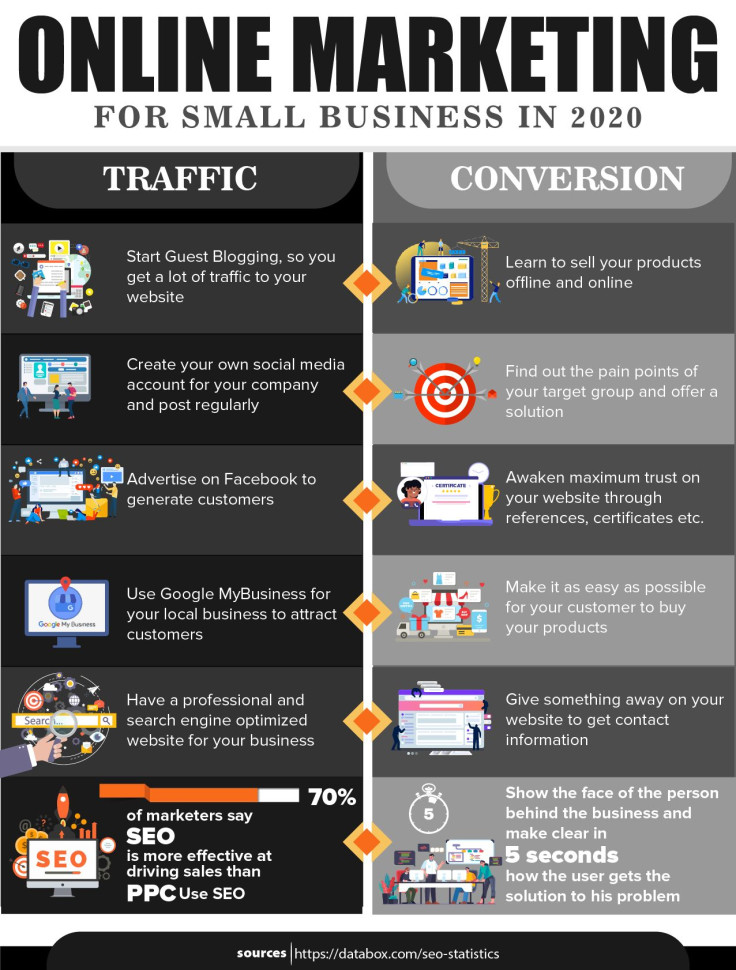Online Marketing For Small Businesses In 2020: The Essentials
KEY POINTS
Thinking about how to take your small business to greater heights in 2020? Then this complete guide on small business online marketing is exactly what you need.
Let's face it; 2020 has not been kind to the world! We are, without a doubt, living in unprecedented, uncertain times.
The Covid-19 pandemic has forced the world to retreat homewards, and with good reason. However, this has naturally had a negative impact on all businesses. Above all, small players have perhaps taken the most significant hit.
As the world begins to open up again in the ‘New Normal,’ online marketing is the best channel small businesses can leverage to turn the tables. However, the task is easier said than done.
With a large number of online marketing channels, modes, methods, and techniques, it can be hard to settle on the right plan of action. Moreover, digital marketing can generate immense amounts of data, which needs to be carefully handled.
How, then, can a small business navigate these choppy waters in 2020? Let’s find out.
The Problem Of Excess
As any small business that takes the first step into the exciting world of digital marketing knows, the realm of the World Wide Web is a veritable maze. And with so many twists and turns, it is quite easy to get lost.
Digital marketing has multiple facets, of which SEO (Search-Engine-Optimization), PPC (Pay-Per-Click) advertising, Social Media, and Content Marketing are most recognized. Add to that Tele-Sales, Email Marketing, and Display advertising, and the choices are more than a person can keep track of.
Sadly, the problem with digital marketing is one of excess. When a business steps into the world of digital media, it’s easy to meander around and take the wrong path. In such situations, the best any business can and should do is to go by the data.
But there also, trouble lurks in a friendly guise.
Metric Matters
Whenever a business embarks upon their online marketing journey, they are advised to focus on the data. Trouble is, any digital marketing tool can generate a colossal data-load. With hundreds of metrics to focus on, losing sight of the real target becomes inevitable.
Take, for example, any social media post. It feels gratifying to get a massive number of likes. But apart from giving the business owners a fuzzy good feeling, it does little more to get them to their target destination.
Which, invariably, is to get more business.
That’s why digital marketing experts around the world suggest narrowing down the metrics to be monitored, and to measure the most relevant ones. As businesses weed out the Vanity Metrics, they focus more on the metrics that truly matter.
Today, we are going to focus on two of the essential online marketing metrics that ensure the success of any small business (yours included): Traffic and Conversions.
The Truth About Traffic
Let’s begin by defining traffic. In a nutshell, traffic is the number of people that visit a web property over a given time. Among digital marketing metrics, traffic is extremely important as it directly correlates to the business’ popularity.
Substantial traffic indicates that people know about the business, and are visiting it online. This is, without a doubt, good news for any small venture, and carries the promise of better marketing performance.
So, how can a business increase its traffic? While many digital marketing gurus prefer to recommend diverse lines, David Hahn, one of the best online marketers and SEO strategists in Germany, recommends SEO.
And as a matter of fact, we agree with him. SEO is decidedly one of the best sources of tapping into the customer psyche and directing traffic to small business web properties. What’s more, a dedicated SEO strategy with OnPage and OffPage SEO can ensure greater reach, more online exposure, and ultimately better business.
Research shows that almost three-fourths of the total number of clicks go to the top three results on the SERPs. This means, unless a business can get to that position, they are bound to miss out on the majority of traffic.
SEO enables a business to build long-term credibility, and a search status that endures. If done rightly, SEO can drive traffic from sources never thought about before. This, of course, requires consistent efforts on the part of the business involved.
That said, SEO is certainly not the only path that can be taken to drive higher footfall to an online destination. PPC, social media advertising, and email marketing are also great channels of garnering more visitors.
There is, however, another side to the coin, and this is what we shall be exploring in the next section.
Cracking The Conversion Code
Consider the following scenario: let’s suppose a business gets about 1,000 visitors a day. The owners are excited and all set to reap in the benefits. They get 2,000 the next day, and 2,500 the next…
But make only seven sales during that entire time. This means that out of 5500 visitors, only 7 took the desired step. This, without a doubt, would be an abysmal performance by any standards.
The point we’re trying to make here is simple: all the traffic in the world won’t save a business unless that traffic is taking the desired action. In digital marketing parlance, this is what’s known as conversion.
Conversion refers to a website visitor taking any desired action intended by the marketing funnel. While the ideal conversion would be sales, it can be anything from newsletter signup to downloading an Ebook.

“Conversion and sales are the Holy Grail of any marketing quest,” says Mirco Thelen , an absolute professional for telephone sales. It doesn’t really matter which marketing channel a business uses. Unless they are getting conversions, it merely means the right needles aren’t moving at all.
So, how can a small business ensure that they reach and sustain the right levels of conversions? The following are some of the crucial steps to take in this direction.
What A Business Can Do To Boost Conversion
1. Invest In Research
Driving traffic is good, but driving intentful traffic is imperative. Unless the visitors to a website are actually interested in the purpose and message of it, there aren’t going to be significant conversions.
That’s why small businesses need to spend ample time and invest resources in customer research. By targeting the demographic with the right intent, a company can ensure that every site visitor takes the desired action, and in some cases, becomes a customer.
2. Unclutter The Landing Page
The page where a visitor lands after clicking a link is of vital importance to ensuring conversions. And while most businesses try to cram everything on the same page, successful ones stick to the basics.
When crafting a landing page, make sure it’s uncluttered and contains only the desired elements that drive the marketing message home. Think Google, whose simply brilliant homepage invites you to search for anything under the sun.
Here’s a thorough guide on how to build the perfect landing page.
3. Guide With Copy
Most websites today make the mistake of filling up their webpages with cut-and-dried, formulaic copy that doesn’t interest the visitors. This naturally drives them away and results in greater bounce rates.
Instead, optimize copy so that instead of informing, it speaks to the visitors. Compelling copy should guide the visitor along the marketing funnel, making sure they convert, and at the same time taking care that they don’t fall off the funnel at any step of the journey.
4. Give A Clear Call-To-Action
It’s a fundamental nature of the human psyche that we don’t do anything unless we’re asked to. Naturally, a business can’t expect a customer to take the desired action unless they are specifically asked to do so.
This is where the Call-To-Action or CTA comes in. A clearly defined CTA is essential for getting visitors to convert from wandering observers to active customers. This can be in the form of a download button, a signup form, or even a ‘Buy Now’ banner.
5. Test, Test, Test
Online marketing is not a one-size-fits-all solution. Businesses must be ready to experiment with different styles, channels, and strategies. What’s essential here is to patiently measure all available data and make the correct decisions to drive conversions.
Final Words
At the end of the day, the success of a business, large or small, depends to a large extent upon their conversion rates. Without the right number of visitors converting into paying customers, a company can’t hope to survive for long.
That being said, with the right strategy and expertise, online marketers can work with small businesses to drive the required traffic and conversions. It only takes a bit of patience, perseverance, and a whole lot of digital chops.
Considering the state of the global economy in present times, traditional marketing efforts are bound to take a hit. In this scenario, it’s digital marketing that’s going to take the driver’s seat for business growth. Already, major players are scurrying to get their skin in the game.
The question is, are you?





















